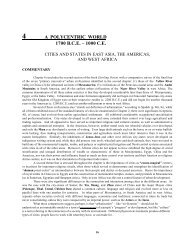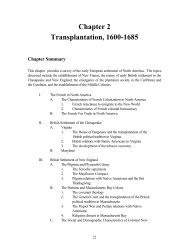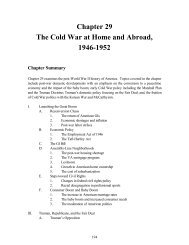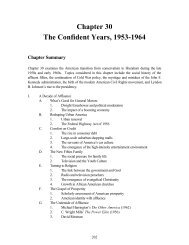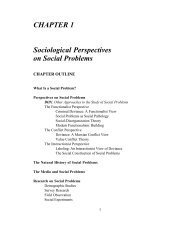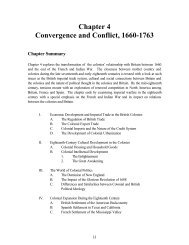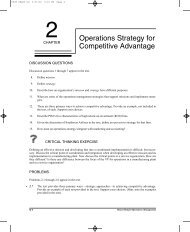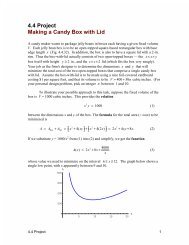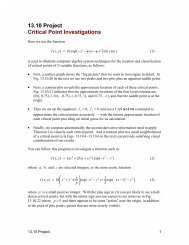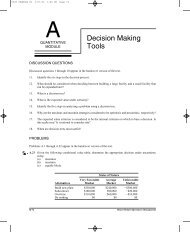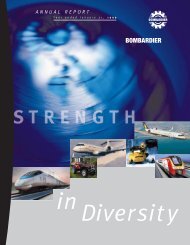Merchandising Operations and the Accounting Cycle - Pearson
Merchandising Operations and the Accounting Cycle - Pearson
Merchandising Operations and the Accounting Cycle - Pearson
You also want an ePaper? Increase the reach of your titles
YUMPU automatically turns print PDFs into web optimized ePapers that Google loves.
266 Part One The Basic Structure of <strong>Accounting</strong><br />
Problem 5-6A Preparing a multi-step income statement <strong>and</strong> a classified balance sheet<br />
under <strong>the</strong> perpetual inventory system (Obj. 4)<br />
Link Back to Chapter 4 (Classified Balance Sheet). Items from <strong>the</strong> accounts of Ste. Rose<br />
Dairy Ltd. at May 31, 2004, follow, listed in alphabetical order. The General Expenses<br />
account summarizes all operating expenses.<br />
Accounts payable.................... $ 20,000<br />
Accounts receivable................ 50,000<br />
Accumulated amortization<br />
—equipment........................ 38,000<br />
Cash .......................................... 7,800<br />
Common stock ........................ 30,000<br />
Cost of goods sold .................. 387,000<br />
Dividends................................. 9,000<br />
Equipment ............................... 146,000<br />
General expenses .................... 120,000<br />
Interest expense....................... 400<br />
Interest payable....................... 1,100<br />
Inventory: May 31, 2004...... $ 65,500<br />
Note payable, long-term ...... 45,000<br />
Retained earnings ................. 27,500<br />
Salary payable ....................... 2,800<br />
Sales discounts ...................... 10,400<br />
Sales returns <strong>and</strong><br />
allowances.......................... 18,000<br />
Sales revenue ......................... 781,000<br />
Selling expenses .................... 140,000<br />
Supplies .................................. 5,100<br />
Unearned sales revenue....... 13,800<br />
Required<br />
1. Prepare <strong>the</strong> business’s multi-step income statement for <strong>the</strong> month ended May 31,<br />
2004.<br />
2. Prepare Ste. Rose Dairy Ltd.’s classified balance sheet in report format at May 31,<br />
2004. Show your computation of <strong>the</strong> May 31, 2004, balance of retained earnings<br />
in a separate schedule. A formal statement of retained earnings is not required.<br />
Problem 5-7A Preparing a single-step income statement <strong>and</strong> a balance sheet under <strong>the</strong><br />
perpetual inventory system (Obj. 4)<br />
Link Back to Chapter 4 (Classified Balance Sheet).<br />
1. Use <strong>the</strong> data of Problem 5-6A to prepare Ste. Rose Dairy Ltd.’s single-step<br />
income statement for <strong>the</strong> month ended May 31, 2004. In addition to <strong>the</strong> data in<br />
Problem 5-6A, Ste. Rose Dairy Ltd. had interest revenue of $200.<br />
2. Prepare Ste. Rose Dairy Ltd.’s classified balance sheet in report format at May<br />
31, 2004. Show your computation of <strong>the</strong> May 31 balance of Retained Earnings. For<br />
this problem, dividends totalled $9,200.<br />
Problem 5-8A Using work sheet data to prepare financial statements <strong>and</strong> evaluate <strong>the</strong><br />
business under <strong>the</strong> perpetual inventory system; multi-step income statement<br />
(Obj. 4, 5)<br />
The trial balance <strong>and</strong> adjustments columns of <strong>the</strong> work sheet of Br<strong>and</strong>on Products<br />
Ltd. include <strong>the</strong> accounts <strong>and</strong> balances at November 30, 2003 shown on <strong>the</strong> following<br />
page.<br />
Required<br />
1. Inventory on h<strong>and</strong> at November 30, 2002, is $32,000. Without entering <strong>the</strong> preceding<br />
data on a formal work sheet, prepare <strong>the</strong> company’s multi-step income<br />
statement for <strong>the</strong> year ended November 30, 2003.<br />
2. Compute <strong>the</strong> gross margin percentage <strong>and</strong> <strong>the</strong> rate of inventory turnover for<br />
2003. For 2002, Br<strong>and</strong>on Product Ltd.’s gross margin percentage was 58 percent,<br />
<strong>and</strong> inventory turnover was 1.8 times during <strong>the</strong> year. Does <strong>the</strong> two-year trend<br />
in <strong>the</strong>se ratios suggest improvement or deterioration in profitability?



